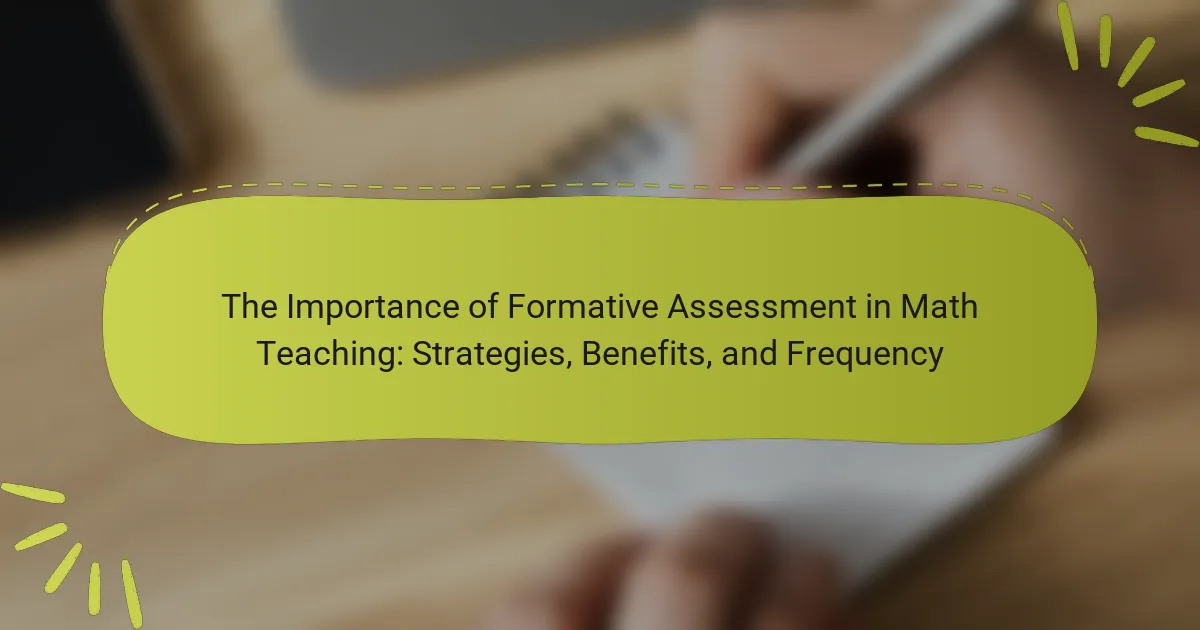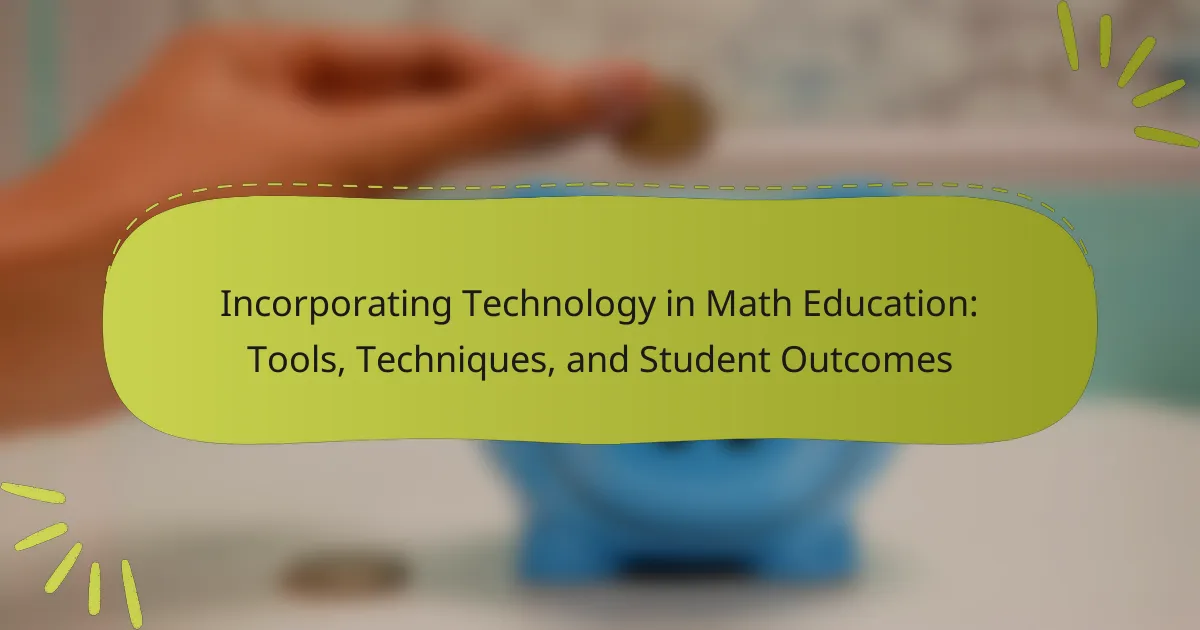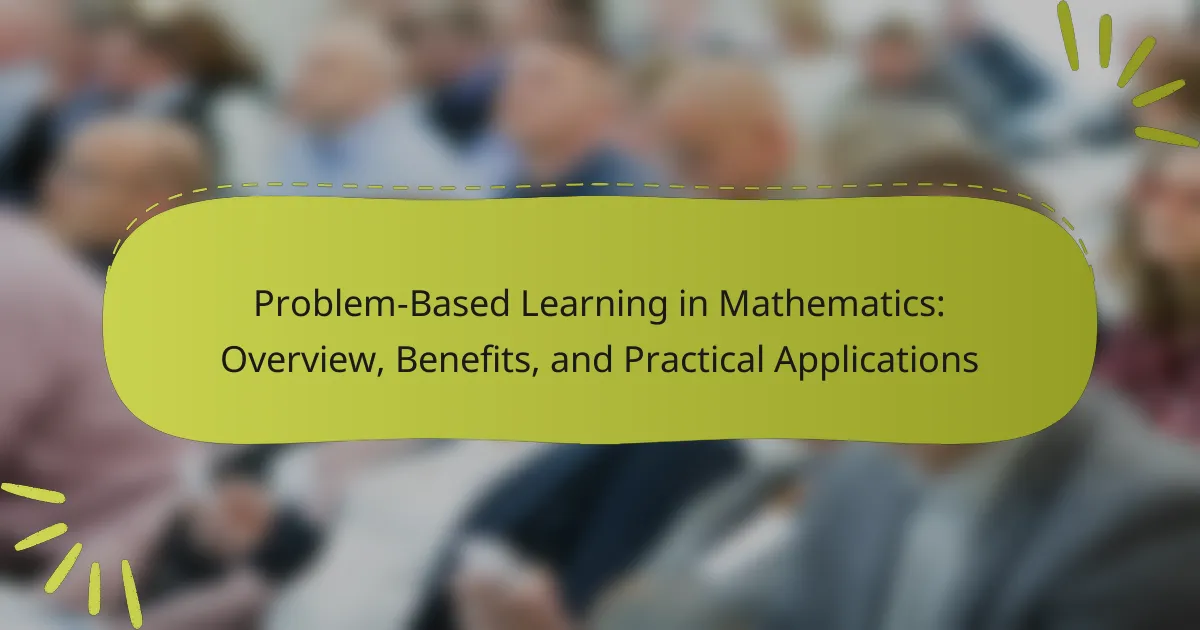Culturally Responsive Teaching in Mathematics is an educational approach that integrates students’ cultural backgrounds into the mathematics learning process. This method enhances relevance and accessibility for diverse student populations by utilizing culturally relevant examples and teaching practices. Research indicates that such strategies improve student engagement and achievement, as students are more likely to participate when their cultures are reflected in the curriculum. Additionally, this approach promotes a sense of belonging and respect within the classroom, ultimately aiming to connect students’ home cultures with their academic experiences. The article will explore the principles, practices, and impacts of Culturally Responsive Teaching in Mathematics.

What is Culturally Responsive Teaching in Mathematics?
Culturally Responsive Teaching in Mathematics is an educational approach that recognizes and incorporates students’ cultural backgrounds into the learning process. This method aims to make mathematics more relevant and accessible to diverse student populations. It encourages the use of culturally relevant examples and teaching practices. Research shows that such practices can enhance student engagement and achievement. For instance, when students see their cultures reflected in the curriculum, they are more likely to participate actively. This approach also fosters a sense of belonging and respect in the classroom. Overall, Culturally Responsive Teaching in Mathematics aims to bridge the gap between students’ home cultures and academic learning.
How does Culturally Responsive Teaching differ from traditional teaching methods?
Culturally Responsive Teaching (CRT) differs from traditional teaching methods by emphasizing the incorporation of students’ cultural backgrounds into the learning process. CRT recognizes and values students’ diverse experiences and perspectives. Traditional teaching often relies on a one-size-fits-all approach, neglecting individual cultural contexts. In contrast, CRT tailors instruction to reflect students’ identities and experiences. This method fosters a more inclusive classroom environment. Studies show that CRT leads to improved student engagement and academic performance. For example, research by Ladson-Billings (1994) demonstrates that culturally relevant pedagogy enhances learning outcomes for marginalized students.
What are the core principles of Culturally Responsive Teaching in Mathematics?
Culturally Responsive Teaching in Mathematics is grounded in several core principles. These principles include recognizing students’ cultural backgrounds, integrating cultural references into the curriculum, and fostering a supportive learning environment.
Recognizing students’ cultural backgrounds involves understanding their unique experiences and perspectives. This acknowledgment helps to create a connection between the students and the mathematical concepts being taught.
Integrating cultural references into the curriculum means incorporating examples and problems that relate to students’ lives. This approach makes mathematics more relevant and engaging for diverse learners.
Fostering a supportive learning environment encourages collaboration and respect among students. It promotes a sense of belonging, which is essential for effective learning.
These principles are supported by research indicating that culturally responsive teaching improves student engagement and achievement in mathematics. Studies show that when students see their culture reflected in their education, they are more likely to succeed academically.
Why is it important to incorporate cultural perspectives in mathematics education?
Incorporating cultural perspectives in mathematics education is crucial for enhancing student engagement and understanding. It acknowledges the diverse backgrounds of students and validates their experiences. Research shows that culturally relevant pedagogy improves academic performance. For instance, a study by Ladson-Billings (1994) highlights that students perform better when their cultural identities are integrated into the curriculum. This approach fosters a sense of belonging and encourages collaboration among students. Moreover, it promotes critical thinking by connecting mathematical concepts to real-world contexts relevant to students’ lives. A culturally responsive curriculum can also help dismantle stereotypes about mathematics as a purely abstract discipline. Overall, integrating cultural perspectives enriches the learning environment and supports equitable education.
What are the key practices in Culturally Responsive Teaching for Mathematics?
Key practices in Culturally Responsive Teaching for Mathematics include recognizing students’ cultural backgrounds and integrating them into lessons. Teachers should use culturally relevant examples to make math relatable. Building strong relationships with students fosters a supportive learning environment. Differentiating instruction caters to diverse learning styles and needs. Encouraging collaboration among students promotes peer learning and respect for different perspectives. Providing real-world applications of math enhances engagement and relevance. Ongoing reflection on teaching practices ensures responsiveness to student feedback and needs. These practices are supported by research indicating improved student outcomes in culturally responsive classrooms.
How can teachers create a culturally inclusive classroom environment?
Teachers can create a culturally inclusive classroom environment by incorporating diverse perspectives into their teaching. They should include materials and resources that reflect various cultures and backgrounds. This practice validates students’ identities and promotes engagement. Teachers can also encourage open discussions about cultural differences and similarities. Establishing a safe space for students to share their experiences fosters inclusivity. Professional development on cultural competency is essential for teachers to understand their students better. Research shows that culturally responsive teaching improves student achievement and self-esteem. According to the National Education Association, students perform better when their cultural backgrounds are acknowledged and respected.
What instructional strategies enhance the effectiveness of Culturally Responsive Teaching?
Instructional strategies that enhance the effectiveness of Culturally Responsive Teaching include building relationships, integrating cultural references, and promoting critical thinking. Building relationships fosters trust between educators and students. This trust encourages open communication and engagement in learning. Integrating cultural references makes learning relevant to students’ lives. It helps students connect new information to their backgrounds. Promoting critical thinking encourages students to analyze and question content. This approach empowers students to voice their perspectives. Research indicates that these strategies lead to increased student achievement and engagement. For instance, a study by Ladson-Billings (1994) highlights the positive impact of culturally relevant pedagogy on student outcomes.
How does Culturally Responsive Teaching impact student learning in Mathematics?
Culturally Responsive Teaching (CRT) enhances student learning in Mathematics by connecting mathematical concepts to students’ cultural backgrounds. This approach fosters a more inclusive learning environment. Students feel valued and understood when their cultural experiences are integrated into lessons. Research shows that CRT can lead to higher engagement and improved academic performance in mathematics. For example, a study by [censured] (2010) indicates that students in culturally responsive classrooms demonstrate increased motivation and achievement. Furthermore, CRT encourages critical thinking by allowing students to explore mathematics through diverse perspectives. This method not only supports mathematical understanding but also promotes a sense of belonging among students.
What evidence exists to support the effectiveness of Culturally Responsive Teaching?
Culturally Responsive Teaching (CRT) enhances student engagement and academic success. Research indicates that CRT improves learning outcomes for diverse student populations. A study by [censured] (2010) found that culturally relevant pedagogy leads to higher academic achievement. Additionally, a meta-analysis by Ladson-Billings (1994) demonstrated that CRT practices positively impact minority students’ performance. Evidence also shows that CRT fosters a sense of belonging among students. This sense of belonging correlates with increased motivation and participation in classroom activities. Furthermore, a report by the National Education Association highlights that CRT reduces dropout rates among marginalized students. Overall, these findings substantiate the effectiveness of Culturally Responsive Teaching in promoting equity in education.
How does student engagement change with Culturally Responsive Teaching practices?
Culturally Responsive Teaching (CRT) practices increase student engagement significantly. CRT practices involve recognizing and valuing students’ cultural backgrounds. This approach fosters a sense of belonging among students. When students see their culture reflected in the curriculum, they become more invested in learning. Research indicates that students engaged in CRT show higher motivation and participation levels. A study by [censured] (2010) highlights that CRT enhances student-teacher relationships, leading to increased engagement. Additionally, when lessons connect to students’ lived experiences, they demonstrate improved academic performance. Overall, CRT practices are effective in transforming student engagement positively.
What challenges do educators face when implementing Culturally Responsive Teaching?
Educators face several challenges when implementing Culturally Responsive Teaching (CRT). One major challenge is a lack of training. Many educators have not received adequate professional development in CRT strategies. This gap can hinder their ability to effectively engage diverse students.
Another challenge is resistance from colleagues or administration. Some educators may encounter skepticism regarding the effectiveness of CRT. This resistance can limit support and resources available for implementing CRT practices.
Additionally, educators may struggle with curriculum adaptation. Modifying existing materials to reflect diverse cultures requires time and effort. Not all educators have the resources or knowledge to make these adaptations effectively.
Moreover, there may be a lack of understanding of students’ cultural backgrounds. Educators often need to invest time in learning about their students’ cultures. Without this understanding, it becomes difficult to create a truly responsive learning environment.
Lastly, systemic barriers can impede the implementation of CRT. Institutional policies may not support diversity initiatives. These barriers can create an environment where CRT is challenging to prioritize.
What are common misconceptions about Culturally Responsive Teaching in Mathematics?
Culturally Responsive Teaching in Mathematics is often misunderstood. One common misconception is that it only involves incorporating cultural references into math problems. In reality, it encompasses a broader pedagogical approach that values students’ cultural backgrounds. Another misconception is that it is only applicable to minority students. Effective culturally responsive teaching benefits all students by fostering an inclusive environment. Some believe it requires teachers to be experts in every culture. However, it is more about being open to learning from students’ experiences. Additionally, some think it lowers academic standards. In fact, it aims to engage students in higher-order thinking. These misconceptions can hinder the effective implementation of culturally responsive strategies in mathematics education.
How can teachers overcome barriers to effective implementation?
Teachers can overcome barriers to effective implementation by adopting culturally responsive teaching strategies. These strategies include understanding students’ cultural backgrounds. Teachers should integrate relevant cultural examples into mathematics lessons. This approach makes learning more relatable and engaging. Providing professional development on culturally responsive practices is essential. Research indicates that teachers who receive training are more effective in diverse classrooms. Collaboration with colleagues can also enhance implementation efforts. Sharing resources and strategies fosters a supportive learning environment. Regularly assessing student understanding helps identify areas needing adjustment. This ensures that teaching methods remain effective and inclusive.
What are best practices for integrating Culturally Responsive Teaching in Mathematics?
Best practices for integrating Culturally Responsive Teaching in Mathematics include using culturally relevant examples and contexts. This approach helps students see the relevance of math in their lives. Incorporating diverse perspectives in problem-solving fosters engagement and understanding. Building relationships with students enhances trust and encourages participation. Differentiating instruction meets varied learning needs and cultural backgrounds. Encouraging collaborative learning promotes peer interaction and cultural exchange. Regularly reflecting on teaching practices ensures continuous improvement and responsiveness to student needs. Research indicates that culturally responsive teaching improves student achievement and engagement in mathematics.
How can educators assess the effectiveness of their Culturally Responsive practices?
Educators can assess the effectiveness of their Culturally Responsive practices through student feedback and academic performance metrics. Collecting qualitative data from students can provide insights into their engagement and understanding. Surveys can measure perceptions of inclusivity and relevance in the curriculum. Additionally, analyzing student performance on assessments can indicate the impact of these practices on learning outcomes. Research shows that culturally responsive teaching can lead to improved academic achievement among diverse student populations. For instance, a study by [censured] (2010) highlights the positive correlation between culturally responsive practices and student success in various subjects.
What resources are available for teachers to enhance their Culturally Responsive Teaching skills?
Teachers can enhance their Culturally Responsive Teaching skills through various resources. Professional development workshops focus on culturally relevant pedagogy. Online courses offer flexible learning options on this topic. Books such as “Culturally Responsive Teaching: Theory, Research, and Practice” provide in-depth insights. Educational websites, like Teaching Tolerance, offer lesson plans and strategies. Research articles highlight effective practices in diverse classrooms. Collaborating with peers can also enhance understanding and implementation. These resources collectively support teachers in fostering an inclusive learning environment.
How can educators foster a culturally responsive mindset in their teaching approach?
Educators can foster a culturally responsive mindset by integrating diverse cultural perspectives into their teaching. This involves recognizing and valuing students’ cultural backgrounds. Educators should incorporate culturally relevant materials and examples in their lessons. They can also engage students in discussions about their cultural experiences. Building strong relationships with students enhances trust and communication. Professional development on cultural competence is essential for educators. Research indicates that culturally responsive teaching improves student engagement and academic performance. For instance, a study by [censured] (2010) highlights the positive impact of culturally responsive pedagogy on student outcomes.
Culturally Responsive Teaching in Mathematics is an educational approach that integrates students’ cultural backgrounds into the learning process, enhancing relevance and accessibility for diverse populations. The article outlines the core principles of this teaching method, including recognizing cultural backgrounds, integrating cultural references, and fostering supportive environments. It discusses how these practices differ from traditional teaching methods, their impact on student engagement and academic performance, and the challenges educators face in implementation. Additionally, the article provides best practices for integrating culturally responsive strategies and resources available for teachers to enhance their skills in this area.



